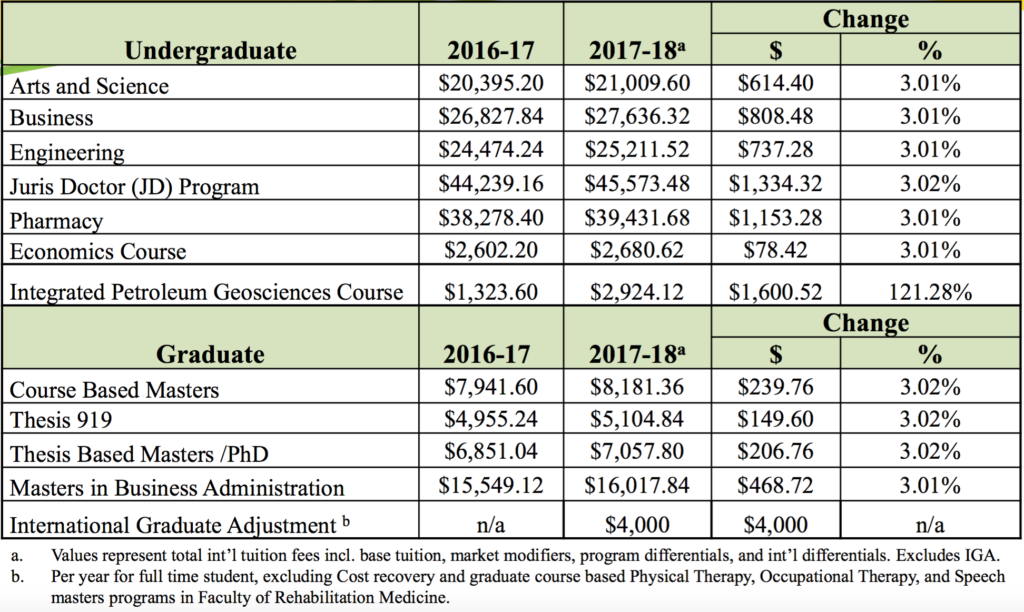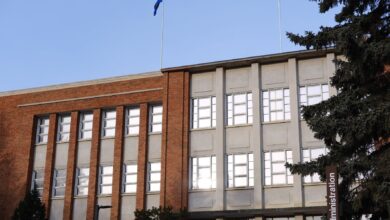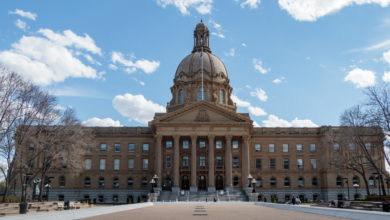International undergrad tuition to increase by three per cent in 2017-18, grad programs to increase as well
 Willow Austin
Willow AustinTuition for 2017-18 is now being set by university administration, and international undergraduates are on track to pay 3.02 per cent more for classes next year.
On November 16, Academic Planning Committee (a subcommittee of General Faculties Council), approved increases to undergraduate international tuition, a $4,000 “sticker price”, which will be added onto tuition but reimbursed immediately after enrollment, and a 121.28 per cent increase to Integrated Petroleum Geosciences courses.
The U of A has approximately 3,500 international undergraduates and 3,500 graduate students. Together, they make up 20 per cent of the university’s population.
Now that the increases have been approved at Academic Planning Committee, they will move through a few other committees and boards. Tuition for 2017-18 will be finalized at the December 16 Board of Governors meeting.
Because programs vary in price, the changes to 2017-18 tuition will vary. The approximate costs for international students have been calculated based on full-time course loads:

Domestic tuition
Domestic tuition will not be going up next year, as Alberta’s tuition freeze has been extended to the end of 2017-18. However, there has been no subsequent announcement of funding to make up for losses that the university had to inflation — if no funding is announced, the tuition freeze will mean a cut to the university’s budget.
In the face of the tuition freeze, the University of Alberta doesn’t have many options to keep its revenues on par with inflation and increasing staff expenses. International tuition, which can’t be regulated by the provincial government like domestic tuition, can be raised to provide the university revenue.
“It was tempting to say, ‘Well, increasing international student tuition is the only way we’ll make this budget balance,’ but we resisted that,” Provost Steven Dew said to the committee. “We held the line at what fraction of the cost is appropriate to ask this group to bear based on the university’s increasing costs.”
International undergraduates feel like ‘cash cows’
Right now, an international undergraduate student pays about $20,395 in tuition per year at the U of A, which is below the national average of $23,425. The U of A’s international cost will continue to stay under the national average despite 3.02 per cent increase.
International students will have to pay between $600 and $1,300 more next year, depending on their programs. Those extra hundreds of dollars can vastly affect students who are already paying steep tuition rates, SU Vice-President (Academic) Marina Banister said.
“There’s this perception that international students who come here are all wealthy and that’s really not the case at all,” Banister said. “And the numbers here can be tricky. You see a three per cent increase and you think it’s no big deal, but it can mean hundreds or thousands of dollars depending on a student’s program.”
At Academic Planning Committee, Banister and other committee members asked whether the U of A could post either projections or historical data on international tuition increases so students could make rough plans when it came to budgeting for their degrees. Dew and University Registrar Lisa Collins said this wasn’t possible because tuition models are in flux with the government, which makes projections difficult, and historical data might be misleading.
“We can’t be promising what tuition levels are going to be in advance of decision-making bodies like the Board of Governors,” Dew said. “And the issue with publishing historical data is that the government is planning to introduce new regulations next fall, and we may not want to release that information if it may not be relevant in the future.”
Banister challenged Dew on whether international students can expect more support if they’re being charged more in tuition. Dew said there likely won’t be an increase in financial aid for international undergraduates, but added that the U of A will be lobbying the government for more resources in this area. Collins said that the university can increase awareness for financial aid and financial literacy workshops.
“It’s important to ensure that we have affordability in our university,” Dew said.
Banister also asked if current international students could be grandfathered into tuition plans so they can have better ideas of what their degrees will cost, but Dew said the “administrative cost” was too high, but the 3.02 per cent increase is consistent with previous years’ increases.
The U of A isn’t alone in rising international costs — students at the University of British Columbia (UBC), the U of A’s main competitor in western Canada, learned that they’d face a 46.8 per cent hike over three years starting in 2015. The UBC, unlike the U of A, opted for a grandfather model that protected current students from the hike.
Murtoza Manzur, president of the International Students’ Association, said he’s not surprised that it will be going up yet again. He wants an explanation on why current students can’t be protected from increases, because right now, international students are often left in the dark.
“Honestly, we feel that we are just cash cows,” Manzur said. “The institution keeps handing its budget shortfall down to us … I feel that doing this is discriminatory.”
[poll id=”39″]
‘Sticker price’ to make graduate programs look more expensive and appealing, Provost says
The 2017-18 tuition proposal tacks on $4,000 “sticker price” onto next year’s international graduate tuition. On paper, this price makes the U of A’s graduate programs look $4,000 more expensive to students. In practice, graduates won’t actually have to pay it, as the $4,000 charge will come with an automatic $4,000 reimbursement, with no application or paperwork needed.
Dew’s rationale for the “sticker price” is that prospective international students with little information will judge a university’s quality according to its price tag. The pseudo-$4,000 increase will make the U of A more marketable to international graduates, Dew said.
“We are way out of market in terms of where our tuition levels are,” Dew told the committee. “We feel that this is affecting how desirable our university is seen by international students.”
International students make up a little less than 40 per cent of the U of A’s graduate population.
The “sticker price” was justified with public data on enrolment and tuition from Canada’s top 15 universities show correlations between more expensive programs and international student demand, Dew said. However, Dew did not present numerical correlations to the committee and later told The Gateway that data showing these correlations was not compiled anywhere — it was “public” in the sense that all universities publish enrolment figures and tuition prices.
“It’s public data, but it’s not necessarily in one place,” Dew said.
In the committee, Sarah Ficko, the Graduate Student Association President, was skeptical that more expensive programs bring in more students, and said international students decide where to study based on a university’s rankings and program offerings.
“I’m concerned that the sticker price is being presented as something that will bring in better students,” Ficko said. “But I’m afraid it’s just going to being in wealthier students.”
Read more: 2017-18 Budget and Tuition Overview presentation.
Integrated Petroleum Geosciences MSc program doubles in price
Graduate students hoping to go into Integrated Petroleum Geosciences (IPG) will be paying double — tuition for the one-year Master’s program is shooting up from $15,883 to $35,089 (individual courses are all increasing from $1,324 to $2,924.12).
The IPG program, offered by the Department of Earth and Atmospheric Sciences and the Department of Physics, is designed to give earth science graduates specialized training for the oil and gas industry.
While the initial proposal to increase IPG course costs at Academic Planning Committee would apply the increases to all students in 2017-18, Ficko successfully motioned for any returning IPG students who happen to not graduate this year to be grandfathered the current tuition rate of $1,324 per course.
For students wanting to learn more or to voice concerns, the Graduate Students’ Association and the SU will be presenting on tuition increases to their councils on November 22 and December 12, respectively. The International Students’ Association will also be presenting to SU council on November 22. Both councils are open to the public and start at 6 p.m. in 2-100 University Hall (Van Vliet Complex).




